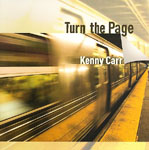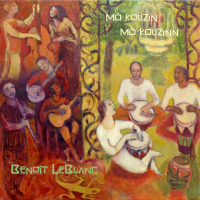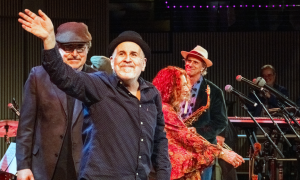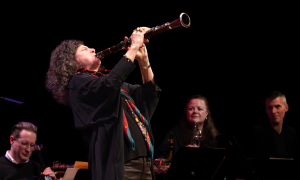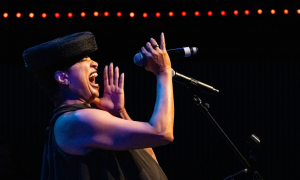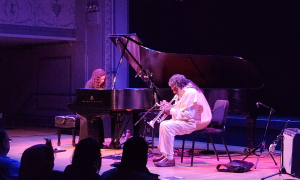Home » Jazz Articles » Live Review » An Anglo/US Convergence: Harris Eisenstadt and Taylor Ho...
An Anglo/US Convergence: Harris Eisenstadt and Taylor Ho Bynum in Cambridge
The centrepiece of the performance was Eisenstadt's 'Convergence,' which began with a wonderful Hawkins piano introduction.
Bateman Auditorium
Cambridge, UK
November 6, 2006
Collaborations between British and American musicians have a long history, but if the format of the Convergence Quartet promised nothing out of the ordinary, the same could not be said of the content. But more of that later. Two rising stars on the North American scene in trumpeter Taylor Ho Bynum—best known for his prominent role in master musician Anthony Braxton's recent oeuvre—and increasingly visible Canadian percussionist Harris Eisenstadt joined with two young Oxford-based musicians, bassist Dominic Lash and pianist Alexander Hawkins.
The genesis of the idea stemmed from a previous visit by Eisenstadt and a desire on the part of the British duo to work with Bynum following his knockout contribution to Braxton's triumph at the Royal Festival Hall in 2004. When the money became available, flights were booked and arrangements made for a short tour. I caught them on 6 November at Cambridge in the Bateman Auditorium (an intimate performance space with good acoustics negating the need for amplification) in Gonville & Caius College. An unfortunate combination of drunken violence and the ailing British railway system conspired to delay my journey, so I arrived just into the second piece of the evening.
After a swingingly lyrical theme the piece broke down into catch-me-if-you-can duets, first an exhibition of extended technique and between Lash and Bynum's trumpet, then a spiky piano/drums pairing. What could be termed "European" free improvisation (though such non-idiomatic improv has increasingly taken root in North America too), blended intriguingly with jazzier extemporization, aided by compositional devices from the pens of all four. Each proved adept at moving smoothly between different camps in an unforced manner, although the compositional elements could be difficult to discern, which is how I like it, as in Lash's piece "Goad," combining musical notation with sometimes obscure written instruction.
The centrepiece of the performance was Eisenstadt's "Convergence," which began with a wonderful Hawkins' piano introduction. Delicate plink-plonk dissonance morphed into swirling tendrils of sound before settling into a rumbling riff, echoed first by the bass and then with jazzy propulsion by the drums. Bynum laid out the gorgeous theme over the top, then took a fine flugelhorn solo, at first melodic but then fragmenting into abstract gesture.
Bynum is at the forefront of a new generation of creative trumpeters, along with the likes of Nate Wooley and Peter Evans (to name two who have impressed over the last couple of years), who are taking the instrument to another level. He boasts an astonishing timbral range, incorporating whistles, buzzes, vocalised yelps, and drones into a highly personal expressiveness, supplemented by imaginative use of a variety of mutes. In one sequence he combined a circular-breathed line with vocalised multiphonics to jaw- dropping effect.
Lash mixed an imaginative range of technique with jazz chops, seeming comfortable whether scratching and scrabbling with his bow, or anchoring the flow with ostinato patterns. The same was true of all four, with Hawkins as happy delving inside the piano as pounding the keys.
Eisenstadt projected calmness, almost seeming to float above his kit, as he moved between pulse and commentary, sometimes modifying his sound with his elbows, or with sheets and blanket draped over parts of the kit for textural variation.
So what was new about this collaboration? Well to my mind it was part of an increasing tendency to look at free improvisation, not as an alternative to jazz, but as yet another idiom to be incorporated alongside more traditional elements in a no- holds-barred approach toward playing music grounded in the original seminal free spirit of jazz. The group touched on some very exciting territory, and I hope they continue to meet, developing the cross-cultural fertilization even further. Like others on the tour, this gig was recorded, and I look forward to any forthcoming memento from this collaboration.
Tags
PREVIOUS / NEXT
Support All About Jazz
 All About Jazz has been a pillar of jazz since 1995, championing it as an art form and, more importantly, supporting the musicians who make it. Our enduring commitment has made "AAJ" one of the most culturally important websites of its kind, read by hundreds of thousands of fans, musicians and industry figures every month.
All About Jazz has been a pillar of jazz since 1995, championing it as an art form and, more importantly, supporting the musicians who make it. Our enduring commitment has made "AAJ" one of the most culturally important websites of its kind, read by hundreds of thousands of fans, musicians and industry figures every month.


